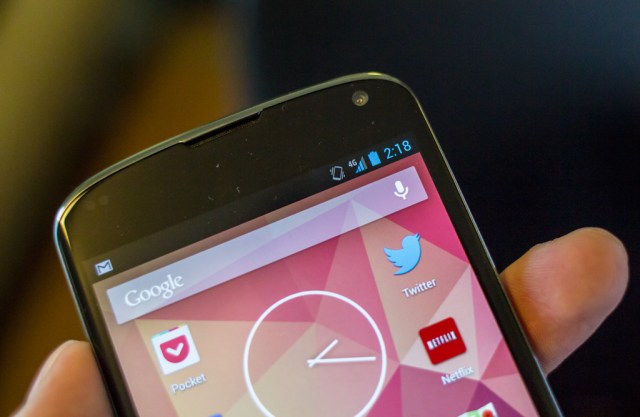 Last Friday, I told you how to get your Google Nexus 4 working on LTE networks in Canada. All through this past weekend and today, I’ve been using that device as my primary phone on the LTE band the entire time. And despite some definite reduction in battery life, I couldn’t be happier with the Nexus 4 now that it’s playing nice with Rogers’ LTE network.
Last Friday, I told you how to get your Google Nexus 4 working on LTE networks in Canada. All through this past weekend and today, I’ve been using that device as my primary phone on the LTE band the entire time. And despite some definite reduction in battery life, I couldn’t be happier with the Nexus 4 now that it’s playing nice with Rogers’ LTE network.
To be clear, the Nexus 4 was a strong contender to begin with. I agree with Chris Velazco’s review: Google’s done a great job creating an untouched Android experience in an attractive hardware package thanks to OEM partner LG. But the lack of LTE was a sore spot, and one that didn’t sit well with me, especially since, as primarily an iPhone user, I just got access to next-gen mobile networks on my daily device via the iPhone 5. And the speed difference isn’t inconsequential: you can see from my network tests in the original how-to post that the LTE network here is orders of magnitude faster than the standard HSPA+ 3G one.
In terms of practical use, that means lightning fast loading of web pages, effortless media streaming and just less time in general waiting for any kind of content grabbed from the web to display. The LTE network was consistently available and strong in my home network of downtown Toronto, and despite the lack of official support from Google or LG, I noticed no unusual drop-outs or failures to connect, in general.
The one sore spot for the Nexus 4 initially was that for some reason, being on a true 4G network disabled Google Now from refreshing. Since this is actually one of my favorite things about Android Jelly Bean, I was more than a little disappointed. Switching to 3G or Wi-Fi got it to refresh, but otherwise, it would just spend a lot of time trying to load and then produce its most recent results instead, ignoring my current location.
Luckily, as of Sunday night, Google now works fine on LTE connections, with no changes to system preferences or updates conducted on my part. It’s almost as if a benevolent fairy at Google flipped a switch and turned the feature back on, knowing it would make all of us Canadian amateur hackers very happy. Regardless of why, Google Now has been working consistently on 4G since.
The last remaining anxiety I had about using the Nexus 4 on LTE full-time was around battery life. But those fears have proven to be mostly unfounded. When Chris reviewed the Nexus 4, he found that it wasn’t all that strong on battery life: it was doing 5.5 hours on a testing loop. When being actively used on LTE, especially for data-intense tasks like streaming video, the Nexus 4 consumes power at a fairly rapid, almost alarming rate. But used normally, it still manages to conserve juice well when in standby mode, and I’ve found that I can at least make it from morning til night with my usual usage habits, which as you might imagine can be fairly demanding.
All in all, my experience with the Nexus 4 as an LTE device gives me plenty of hope that Google will officially support it in an update, and possible release LTE versions compatible with U.S. and international networks down the road, too. Even without it, a $300 smartphone this good is a triumph, but with LTE included, it’s a nearly unbeatable package.